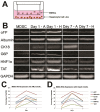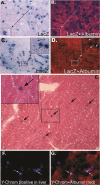Skeletal muscle-derived stem cells differentiate into hepatocyte-like cells and aid in liver regeneration
- PMID: 20830239
- PMCID: PMC2933388
Skeletal muscle-derived stem cells differentiate into hepatocyte-like cells and aid in liver regeneration
Abstract
The liver is unique for its ability to regenerate after injury, however, critical injuries or disease cause it to lose this quality. Stem cells have been explored as a possibility to restore the function of seriously damaged livers, based on their self-renewability and multiple differentiation capacity. These experiments examine the ability of muscle derived stem cells (MDSCs) to differentiate into hepatocyte-like cells in vitro and acquire functional liver attributes for repairing damaged livers. In vitro experiments were performed using MDSCs from postnatal mice and mouse hepatocyte cell lines. Our data revealed that MDSCs differentiated into hepatocyte-like cells and expressed liver cell markers, albumin, hepatocyte nuclear factor 4 α, and alpha feto-protein, both at the RNA and protein level. Additionally, in vivo studies showed successful engraftment of MDSCs into hepatectomized mouse livers of mice. These results provide evidence suggesting that MDSCs have the capacity to differentiate into liver cell-like cells and may serve as potential candidates to aid in liver regeneration.
Keywords: Differentiation; Hepatectomy; Liver; Muscle Derived Stem Cells.
Figures




References
-
- Ebrahimkhani MR, Elsharkawy AM, Mann DA. Wound healing and local neuroendocrine regulation in the injured liver. Expert Rev Mol Med. 2008;10:e11. - PubMed
-
- Michalopoulos GK, DeFrances MC. Liver regeneration. Science. 1997;276:60–66. - PubMed
-
- Iimuro Y, Nishio T, Morimoto T, Nitta T, Stefanovic B, Choi SK, Brenner DA, Yamaoka Y. Delivery of matrix metalloproteinase-1 attenuates established liver fibrosis in the rat. Gastroenterology. 2003;124:445–458. - PubMed
Publication types
MeSH terms
Grants and funding
LinkOut - more resources
Full Text Sources
Medical
